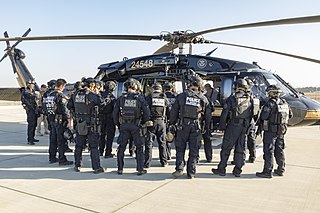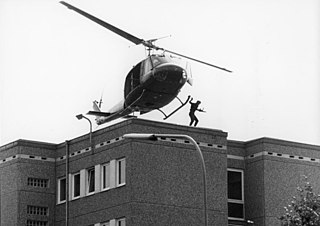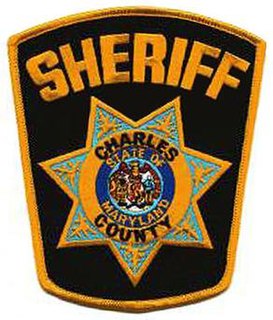
Harford County is located in the U.S. state of Maryland. As of the 2020 census, the population was 260,924. Its county seat is Bel Air. Harford County is included in the Baltimore-Columbia-Towson, MD Metropolitan Statistical Area, which is also included in the Washington-Baltimore-Arlington, DC-MD-VA-WV-PA Combined Statistical Area.

In the United States, a SWAT team is a police tactical unit that uses specialized or military equipment and tactics. Although they were first created in the 1960s to handle riot control or violent confrontations with criminals, the number and usage of SWAT teams increased in the 1980s and 1990s during the War on Drugs and later in the aftermath of the September 11 attacks. In the United States by 2005, SWAT teams were deployed 50,000 times every year, almost 80% of the time to serve search warrants, most often for narcotics. By 2015 that number had increased to nearly 80,000 times a year. SWAT teams are increasingly equipped with military-type hardware and trained to deploy against threats of terrorism, for crowd control, hostage taking, and in situations beyond the capabilities of ordinary law enforcement, sometimes deemed "high-risk".

A police tactical unit (PTU) is a specialized police unit formed and trained to handle situations that are beyond the capabilities of ordinary law enforcement units because of the level of violence - or risk of violence - involved. A police tactical unit's taskings may include executing dangerous search warrants and executing arrest warrants for dangerous persons, arresting or neutralizing dangerous or mentally ill armed persons, and intervening in high risk situations such as shootouts, hostage and terrorist incidents.

The Maryland State Police (MSP), officially the Maryland Department of State Police (MDSP), is the official state police force of the U.S. state of Maryland. The Maryland State Police is headquartered at 1201 Reisterstown Road in the Pikesville CDP in unincorporated Baltimore County.

The Pittsburgh Police (PBP), officially the Pittsburgh Bureau of Police, is the largest law enforcement agency in Western Pennsylvania and the third largest in Pennsylvania. The modern force of salaried and professional officers was founded in 1857 but dates back to the night watchmen beginning in 1794, and the subsequent day patrols in the early 19th century, in the then borough of Pittsburgh. By 1952 the Bureau had a strength of 1,400 sworn officers in July 1985, 1,200 and by November 1989, 1,040.

The Anne Arundel County Police Department is the primary law enforcement agency of Anne Arundel County, Maryland, United States, serving a population of more than 564,195 per 2015 census estimates across 588 square miles (1,500 km2) of jurisdiction. The Department was created by an Act of the Maryland General Assembly in 1937, and originally consisted of a Chief of Police, three sergeants, and seventeen patrolmen.

The Prince George's County Police Department (PGPD) is the primary law enforcement agency in Prince George's County, Maryland in the United States, servicing a population of over 900,000 residents and visitors within 498 square miles (1,290 km2) of jurisdiction.

The Carroll County Sheriff's Office (CCSO) was created in 1837 and is the primary law enforcement agency for Carroll County, MD. It services a population of 170,260 people within 449.13 square miles.

The Greenbelt Police Department (GPD) is the primary law enforcement agency servicing a population of 21,972 within 6.5 square miles (17 km2) of the city of Greenbelt.
The Laurel Police Department (LPD) is a nationally accredited, full-service police department servicing a population of 21,945 persons within 3.8 square miles (9.8 km2) of the municipality of Laurel in the U.S. state of Maryland in Prince Georges County. The LPD also maintains its own emergency communications (dispatch) and temporary prisoner detention facility.

The Aberdeen Police Department (APD) is the primary police agency servicing a population of 14,130 within 6.4 square miles (17 km2) of the municipality of Aberdeen, Maryland.

The Frederick County Sheriff's Office (FCSO) is the primary law enforcement agency serving a population of 222,938 residents within the 662.88 square miles (1,717 km2) area of Frederick County, Maryland.

The Charles County Sheriff's Office (CCSO) is a nationally accredited, full-service law enforcement agency servicing a population of 140,416 within 461.0 square miles (1,194 km2) of Charles County, Maryland.
The drug raid at the residence of Cheye Calvo, then-mayor of Berwyn Heights, Maryland, was a controversial action taken by the Prince George's County Sheriff's Office and Police Department on July 29, 2008. The raid was the culmination of an investigation that began in Arizona, where a package containing 32 pounds (15 kg) of marijuana was intercepted in a warehouse, addressed to the mayor's residence. Instead of confiscating the package, police allowed it to be delivered. Upon arrival, a SWAT team raided the house and held Calvo and his mother-in-law at gunpoint, and shot and killed his two dogs, one as it attempted to run away.
The Lafayette Police Department is the principal law enforcement agency in Lafayette, Louisiana, with the exception of the campus of University of Louisiana, which falls under the responsibility of the UL Police.

The Bel Air Police Department (BAPD) is a full-service agency servicing the incorporated Municipality of Bel Air, Maryland. The department is located in the Harford county seat of Bel Air at 39 North Hickory Avenue, Bel Air, Maryland 21014. BAPD is Bel Air's primary law enforcement agency which was established in 1874.

The Lenco BearCat is a wheeled SWAT vehicle designed for military and law enforcement use. It is in use by several military forces and law enforcement agencies around the world.

The militarization of police is the use of military equipment and tactics by law enforcement officers. This includes the use of armored personnel carriers (APCs), assault rifles, submachine guns, flashbang grenades, sniper rifles, and SWAT teams. The militarization of law enforcement is also associated with intelligence agency–style information gathering aimed at the public and political activists and with a more aggressive style of law enforcement. Criminal justice professor Peter Kraska has defined militarization of police as "the process whereby civilian police increasingly draw from, and pattern themselves around, the tenets of militarism and the military model".






















